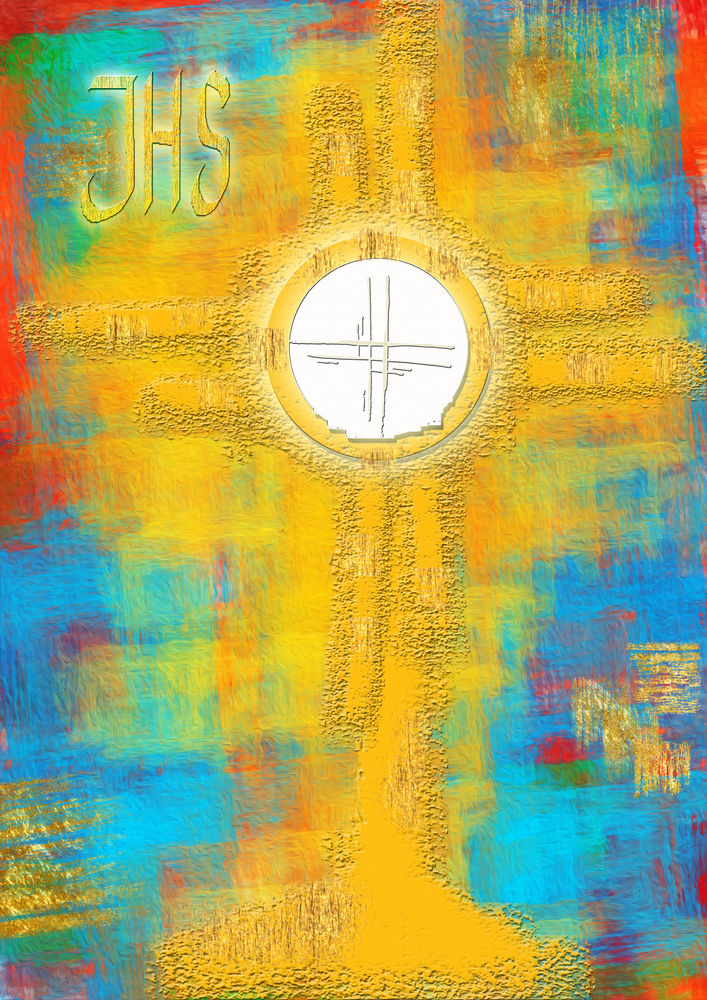Liturgyrnand the Solemnity of the Most Holy Body and Blood of Christ
As we approach the celebration of the Solemnityrnof the Most Holy Body and Blood of Christ, formerly known as Corpus Christi, considerrnthe 2001 statement of the United States Catholic Bishops: The Real Presence ofrnJesus Christ in the Sacrament of the Eucharist: Basic Questions and Answers.
“The work of the Holy Spirit in the celebrationrnof the Eucharist is twofold … On the one hand, it is through the power of thernHoly Spirit that the risen Christ and his act of sacrifice become present. … Onrnthe other hand, at the same time the priest also asks the Father to send thernHoly Spirit down upon the whole assembly so that ‘those who take part in thernEucharist may be one body and one spirit’ (Catechism, no. 1353). … It is through the Holy Spirit thatrnthe gift of the Eucharistic Body of Christ comes to us and through the HolyrnSpirit that we are joined to Christ and each other as the Mystical Body ofrnChrist…. the celebration of the Eucharist does not just unite us to God asrnindividuals who are isolated from one another. Rather, we are united to Christrntogether with all the other members of the Mystical Body.”
In preparing our liturgies for this celebration,rnwe need to remember this twofold presence of the body of Christ. Our liturgiesrnneed to reflect our understanding not only of the real presence of Christ inrnthe elements of the Eucharist, but also the real presence of Christ in thernconsecrated and transformed body of Christ, the church gathered. We, too, arernsanctified and substantially changed.
Therefore, prepare a welcoming presencerneverywhere in the church building as people are arriving for Mass. Be sure everyonernwho enters feels they are connected and integral to the celebration.
Attend to the texts of the assembly songs. Bernsure to choose gathering songs and communion songs that include expression ofrnthe twofold presence of Christ mentioned above.
Early in the week prior to this celebration, haverna scripture reflection gathering of the lectors for all of the Masses. At thisrngathering, the lectors can gain a better understanding of the readings andrnrehearse how they will proclaim them at the Sunday liturgy.
Be sure the homily speaks of the twofoldrnmeaning of the Body of Christ.
Be attentive to the Rite of Communion in thernMass. This might be a good day for the homilist or presider to call allrnparticipants to a common posture during the sharing in communion. In ourrnarchdiocese, the common posture after we have shared in communion is to remainrnstanding until all have received. This unity of posture emphasizes our unity inrnthat twofold meaning of the body of Christ.
This would also be an appropriate day to extendrnthe Mass to include Eucharistic Exposition, a brief time of Adoration, andrnBenediction. It is best to inform the members of the parish well in advance ofrnthe plan to hold this time of prayer. Advance communication is not onlyrninformative; it is also an act of respect.
The process of Exposition will need to be explainedrnto the assembly, and the homily might be a good time to do that. It isrnespecially important that individuals who choose not to stay for Exposition berndirected to the call for respectful silence after the Prayer After Communion,rnsince there will be no concluding rites or closing song.
Exposition should take place only after Massesrnwhere there is sufficient time to do so — final morning Mass or final afternoonrnMass. Please refer to the ritual book “Order for the Solemn Exposition of thernHoly Eucharist.”
“Probably all of us …remember celebrating the Feast of CorpusrnChristi…throughout our lives as Catholics. The emphasis always was on adorationrnof the Blessed Sacrament, recognizing the living presence of Jesus in the breadrnand the wine that were consecrated at Mass. We believed, and still believe withrngreat strength, that Jesus is truly present under those forms of bread andrnwine. But there's another reality about the Blessed Sacrament that we perhapsrnhave not given as much emphasis to as we should, because if we listen carefullyrnto the scriptures, we discover that not only are those elements of bread andrnwine transformed into the body and blood of Christ, but also the community ofrndisciples — we, who are the church — are transformed into the body and blood ofrnChrist. We become the living Jesus, present in our world” (Bishop ThomasrnGumbleton, 2008).

